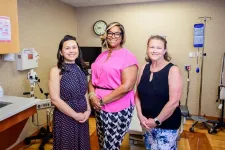(Press-News.org) EMBARGOED UNTIL 2 p.m. Monday, July 22, 2024
Contact:
Jillian McKoy ,jpmckoy@bu.edu
Michael Saunders, msaunder@bu.edu
Jarka Meleszkiewicz, jarka.meleszkiewicz@bristol.ac.uk
##
New Study Identifies Two Proteins That May Contribute to Stroke Recurrence
The study discovered genetic markers in inflammation that may be related to a second stroke or other major cardiovascular event following a stroke. These findings could help identify drug targets to mitigate stroke-related disability and mortality.
People who experience an arterial ischemic stroke (AIS) or transient ischemic stroke (TIA) are at an increased risk of suffering a second stroke or other major adverse cardiovascular event (MACE), making it critically important to identify risk factors and treatments to prevent these subsequent occurrences.
A new study led by Boston University School of Public Health (BUSPH), the National Institute for Health and Care Research (NIHR) Bristol Biomedical Research Centre (Bristol BRC), and Veteran’s Affairs Boston Healthcare System (VA Boston), has identified new genetic and molecular risk factors that may reveal new pathways for treating patients after they experience their first stroke.
Published in Stroke, a journal of the American Heart Association, the study identified CCL27 and TNFRSF14, two proteins that are associated with subsequent MACE, but not initial strokes. These proteins are known to activate inflammation, which plays a key role in the development of strokes and many chronic conditions and diseases. The findings suggest that inflammation is a contributing factor to MACE outcomes among people after they have their first stroke.
“While previous studies have found associations between inflammation and incident AIS/MACE, our study found that these causal proteins may also have a role in subsequent MACE, which could lead to potential novel drug targets,” says study co-lead author Nimish Adhikari, a PhD student in biostatistics at BUSPH and VA Boston. The study was also co-led by Andrew Elmore, senior research associate in health data science at NIHR Bristol BRC.
Utilizing genetic information and medical history data from two large biobanks, the VA’s Million Veteran Program and UK Biobank, the research team conducted ancestry-specific genome-wide association studies (GWAS) to find associations between DNA and incident and subsequent AIS and MACE.
GWAS are typically performed to determine whether individuals have had a medical event for the first time, but applying this method to subsequent MACE events could shed novel insights about stroke progression, information that would be valuable for therapeutic drug identification, the researchers say.
In total, the researchers examined 93,422 individuals who had an incident stroke, among which 51,929 had subsequent MACE and 45,120 had subsequent AIS.
In population specific analyses, they observed two significant genetic variants: rs76472767, near gene RNF220 on chromosome 1 in the African ancestry GWAS for subsequent MACE, and rs13294166, near gene LINC01492 on chromosome 9 in the same ancestry GWAS for subsequent AIS.
“We used that data to find if there were certain molecules that were associated with either incident or subsequent states,” says Elmore. “From that, we were able to identify a link between certain molecules that play a part in inflammation and these stroke and MACE outcomes.”
While the prevalence of stroke has declined worldwide over the last three decades, it is still the second-leading cause of death and third-leading cause of disability across the globe, and it remains a significant public health issue. Stroke also continues to disproportionately affect populations among racial, ethnic, socioeconomic, and geographical lines, furthering health inequities in both high- and low-income countries. Identifying novel drug targets for new therapeutic interventions that thwart stroke progression could save millions of people from experiencing stroke-related disability and mortality.
It’s unknown if targeting other modifiable risk factors for stroke could also offer pathways for effective treatment after someone experiences their first stroke.
“We are looking forward to extending this research to other cardiometabolic outcomes beyond stroke,” says co-senior and corresponding author Gina Peloso, associate professor of biostatistics at BUSPH.
Lavinia Paternoster, associate professor in genetic epidemiology at NIHR Bristol BRC and Bristol Medical School, and Kelly Cho, director of data science and analytics at the division of population health and data science, VA Boston Healthcare System and associate professor of medicine at Mass General Brigham, Harvard Medical School, are also co-senior authors.
**
About Boston University School of Public Health
Founded in 1976, Boston University School of Public Health is one of the top ten ranked schools of public health in the world. It offers master's- and doctoral-level education in public health. The faculty in six departments conduct policy-changing public health research around the world, with the mission of improving the health of populations—especially the disadvantaged, underserved, and vulnerable—locally and globally.
About the National Institute for Health and Care Research
The mission of the National Institute for Health and Care Research (NIHR) is to improve the health and wealth of the nation through research. We do this by:
Funding high quality, timely research that benefits the NHS, public health and social care;
Investing in world-class expertise, facilities and a skilled delivery workforce to translate discoveries into improved treatments and services;
Partnering with patients, service users, carers and communities, improving the relevance, quality and impact of our research;
Attracting, training and supporting the best researchers to tackle complex health and social care challenges;
Collaborating with other public funders, charities and industry to help shape a cohesive and globally competitive research system;
Funding applied global health research and training to meet the needs of the poorest people in low and middle income countries.
NIHR is funded by the Department of Health and Social Care. Its work in low and middle income countries is principally funded through UK Aid from the UK government.
About NIHR Bristol Biomedical Research Centre
NIHR Bristol Biomedical Research Centre’s (BRC) innovative biomedical research takes science from the laboratory bench or computer and develops it into new drugs, treatments or health advice. Its world-leading scientists work on many aspects of health, from the role played by individual genes and proteins to analyzing large collections of data on hundreds of thousands of people. Bristol BRC is unique among the NIHR’s 20 BRCs across England, thanks to its expertise in ground-breaking population health research.
About the Division of Population Health and Data Science, VA Boston Healthcare System
VA Boston Healthcare System conducts research to discover knowledge, develop VA scientists and health care leaders, and create innovations that advance health care for Veterans and the nation. The Division of Population Health and Data Science at the Massachusetts Veterans Epidemiology Research and Information Collaborative, VA Boston serves as a national resource to foster population health research in the VA. It consists of multiple national centers and programs funded by the VA Office of Research and Development including the Boston Cooperative Studies Program Epidemiology Center, the Million Veteran Program Coordinating Center and Centralized Interactive Phenomics Resource (CIPHER) Program.
END
New study identifies two proteins that may contribute to stroke recurrence
The study discovered genetic markers in inflammation that may be related to a second stroke or other major cardiovascular event following a stroke. These findings could help identify drug targets to mitigate stroke-related disability and mortality.
2024-07-22
ELSE PRESS RELEASES FROM THIS DATE:
Virtual reality training for physicians aims to heal disparities in Black maternal health care
2024-07-22
CHAMPAIGN, Ill. — During a checkup with her obstetrician, Marilyn Hayes tells him about overwhelming exhaustion and possible symptoms of postpartum depression, such as feeling unsafe. Hayes, a Black woman, grows increasingly frustrated as her white, male physician, Dr. Richard Flynn, dismisses her symptoms and ignores her wishes when she refuses medication. Hayes becomes visibly uncomfortable when Flynn touches her without permission and makes comments steeped in Black stereotypes, such as assuming that ...
Science, Social Studies classes can help young English-learning students learn to read and write in English
2024-07-22
A new study finds that science and social studies classes may also help young students learn English, even when those classes include difficult and technical vocabulary.
The study, which observed first- and second-grade students in 30 elementary schools in North Carolina, encouraged teachers to keep their English-learning students in class during science and social studies lessons. Science and social studies textbooks in those grades are often relatively technical and difficult for students, so traditional teaching methods in North Carolina encourage teachers to remove English-learning students from those content classes ...
Wijesekera receives funding for FHWA driving simulator support research: Hands-on support for CDA/CARMA - ARCHER Integration Phase I
2024-07-22
Duminda Wijesekera, Professor, Cybersecurity Engineering; Professor, Computer Science, received funding for the project: “FHWA Driving Simulator Support Research: Hands-on support for CDA/CARMA - ARCHER Integration Phase I.”
He will evaluate and test the Nvidia Drive Sim to understand functionality, behaviors, limitations, and interfaces that would be required in full integration.
Nvidia Drive Sim is a simulation platform for autonomous vehicles.
He will also work to discern the ...
Study: Retail viability in Fairfax City mixed use development
2024-07-22
Center for Retail Transformation (CRT) and Center for Real Estate Entrepreneurship (CREE) jointly received funding to study retail viability led by Mehmet Altug, Associate Professor, Information Systems and Operations Management and Director of CRT, Costello College of Business.
Led by Mehmet Altug, the two centers CRT and CREE at Costello College of Business have teamed up to determine market-specific retail opportunities within Fairfax City, specifically within five Small Area Plans. The project will specifically consider ...
Converting captured carbon to fuel: Study assesses what’s practical and what’s not
2024-07-22
The struggle to cut emissions is real.
Last year, the world emitted more than 37 billion metric tons of carbon dioxide, setting a new record high. As a result, sucking CO2 out of the atmosphere has become an increasingly popular idea. Governments worldwide are banking on this technology, called direct air capture, to help them achieve climate goals and avoid the worst consequences of climate change.
But despite more than a dozen direct air capture facilities being up and running around the globe already, the technology ...
University of Houston flexes scientific muscle with breakthrough in skeletal muscle regeneration
2024-07-22
Newly published research from the University of Houston College of Pharmacy identifies key mechanisms of skeletal muscle regeneration and growth of muscles following resistance exercise. It’s a finding that opens the door to the development of targeted therapies for various muscle disorders, like Muscular Dystrophy, which affect millions of people worldwide.
When it comes to muscles and muscle disorders, the importance of a discovery like this cannot be overstated.
The muscle of muscles
The ...
Argonne-led research working toward reducing electronic waste with biodegradable luminescent polymers
2024-07-22
From your car’s navigation display to the screen you are reading this on, luminescent polymers — a class of flexible materials that contain light-emitting molecules — are used in a variety of today’s electronics. Luminescent polymers stand out for their light-emitting capability, coupled with their remarkable flexibility and stretchability, showcasing vast potential across diverse fields of application.
However, once these electronics reach their end use, they are discarded, piling up in landfills or buried underground. Recycling this electronic waste is complex, requiring expensive ...
B cell biohack: USC engineers immune cells to churn out custom antibodies
2024-07-22
USC scientists have discovered a way to turn the body’s B cells into tiny surveillance machines and antibody factories that can pump out specially designed antibodies to destroy cancer cells or HIV, two of medicine’s most formidable foes.
The research, published today in Nature Biomedical Engineering, describes a technique for editing the genes of immune cells called B cells, turbocharging them to fight even the sneakiest invaders. The work is an important advance in harnessing the power of antibodies to treat conditions ranging from Alzheimer’s ...
Understanding how a red seaweed reduces methane emissions from cows
2024-07-22
Methane is the second-largest contributor to climate warming after carbon dioxide, and so scientists have put a lot of attention toward addressing one of the top sources: methane emissions from livestock. In other words, cow burps are bad for the planet.
Farmers add various seaweeds to cow diets as a source of protein, unsaturated fats, and other health-promoting ingredients that provide immediate energy, says Dipti Pitta of the University of Pennsylvania School of Veterinary Medicine, and a 2016 study in Australia found that feeding sheep a species ...
Genome study informs restoration of American chestnut tree
2024-07-22
Native trees adapt to the climate and environmental conditions of their area to survive. Researchers in the College of Natural Resources and Environment in collaboration with the American Chestnut Foundation confirmed this by examining the genome of American chestnut trees sampled throughout the Appalachian Mountain range and grouping the samples according to their specific environmental region.
The research, recently published in the Proceedings of the National Academy of Sciences journal, has the potential to help the ...
LAST 30 PRESS RELEASES:
Longest observation of an active solar region
Why nail-biting, procrastination and other self-sabotaging behaviors are rooted in survival instincts
Regional variations in mechanical properties of porcine leptomeninges
Artificial empathy in therapy and healthcare: advancements in interpersonal interaction technologies
Why some brains switch gears more efficiently than others
UVA’s Jundong Li wins ICDM’S 2025 Tao Li Award for data mining, machine learning
UVA’s low-power, high-performance computer power player Mircea Stan earns National Academy of Inventors fellowship
Not playing by the rules: USU researcher explores filamentous algae dynamics in rivers
Do our body clocks influence our risk of dementia?
Anthropologists offer new evidence of bipedalism in long-debated fossil discovery
Safer receipt paper from wood
Dosage-sensitive genes suggest no whole-genome duplications in ancestral angiosperm
First ancient human herpesvirus genomes document their deep history with humans
Why Some Bacteria Survive Antibiotics and How to Stop Them - New study reveals that bacteria can survive antibiotic treatment through two fundamentally different “shutdown modes”
UCLA study links scar healing to dangerous placenta condition
CHANGE-seq-BE finds off-target changes in the genome from base editors
The Journal of Nuclear Medicine Ahead-of-Print Tip Sheet: January 2, 2026
Delayed or absent first dose of measles, mumps, and rubella vaccination
Trends in US preterm birth rates by household income and race and ethnicity
Study identifies potential biomarker linked to progression and brain inflammation in multiple sclerosis
Many mothers in Norway do not show up for postnatal check-ups
Researchers want to find out why quick clay is so unstable
Superradiant spins show teamwork at the quantum scale
Cleveland Clinic Research links tumor bacteria to immunotherapy resistance in head and neck cancer
First Editorial of 2026: Resisting AI slop
Joint ground- and space-based observations reveal Saturn-mass rogue planet
Inheritable genetic variant offers protection against blood cancer risk and progression
Pigs settled Pacific islands alongside early human voyagers
A Coral reef’s daily pulse reshapes microbes in surrounding waters
EAST Tokamak experiments exceed plasma density limit, offering new approach to fusion ignition
[Press-News.org] New study identifies two proteins that may contribute to stroke recurrenceThe study discovered genetic markers in inflammation that may be related to a second stroke or other major cardiovascular event following a stroke. These findings could help identify drug targets to mitigate stroke-related disability and mortality.



